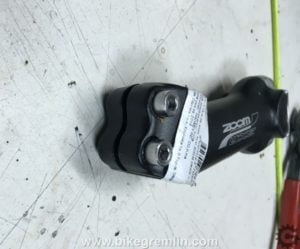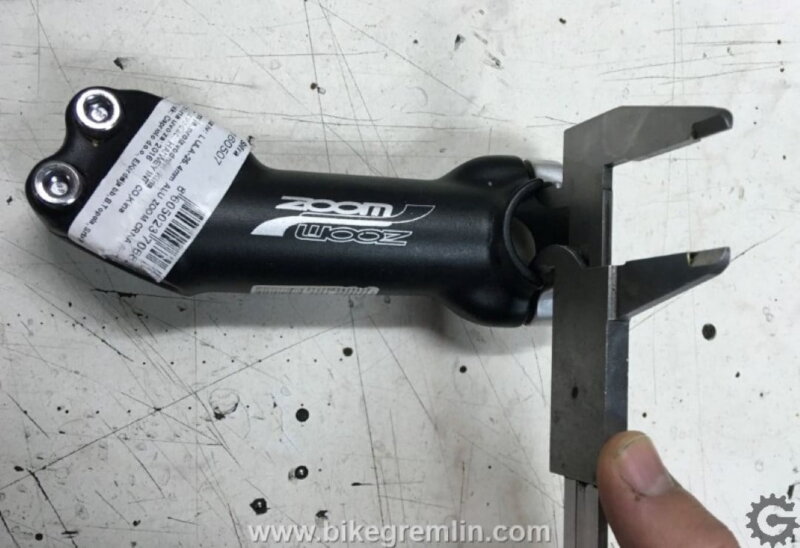Stem types and sizes explained. 🙂
If you have any questions (or additions and corrections), please use the BikeGremlin forum:
www.bikegremlin.net
Table of contents (T.O.C.):
- Introduction
- Types of stems
1.1. Quill stem
1.2. Threadless stem - Important dimensions and how to measure
2.1. Handlebar (clamp) attachment diameter
2.2. Steering column attachment diameter - Stem dimension standards
3.1. Handlebar clamp dimension standards
3.2. Steering column attachment dimension standards
…3.2.1. Threaded stems
…3.2.2. Threadless stems
TL/DR
There are two major stem types: threadless (“ahead”), and quill stems.
Each stem has two major dimensions: handlebar attachment diameter, and the fork steering column attachment diameter.
In this article I’ve explained what’s what and how to measure it (in case you need to buy a new stem).
0. Introduction
This post explains stem size standards in terms of steering column attachment and handlebar attachment at the opposite end of the stem. Other dimensions, such as stem length and angle will be explained in a separate post.
A tip:
When buying a stem, unless you already have handlebars of a different standard, I recommend you choose a stem with a modern OS (“oversized”) bar attachment diameter (table 1 lists the standard dimensions).
Dimensions and type of steering column attachment depend on your bike’s fork, so that’s a bit harder to “change” – though, if choosing a frame, I recommend you look for one with a 1 1/8″ steering column diameter and a threadless fork – for several reasons.
1. Types of stems
There are two types of stems (in terms of standard attachment dimension): quill (for threaded forks) and threadless (a.k.a. ahead) stems (for threadless forks).
1.1. Quill stem
Quill stem is attached to the steering column by inserting it into the steering column and tightening a bolt on top of the stem, that pulls the quill upwards, making the lower stem diameter wider. Without much going into details and various designs, the basic principle is shown in picture 1.


1.2. Threadless stem
Threadless stems have a slot at the steering column attachment end. It is fastened by sliding it onto the steering column, and then tightening the pinch bolt(s) that hold it fastened.

Picture 2


2. Important dimensions and how to measure
Stems are made with various lengths and angles. Picture 2a shows a quill stem with a shorter neck, angled downwards, next to a threadless stem with a longer neck. Lenghts and angles differ and are important when fitting a bicycle to suit a rider. However, in terms of (attachment) standards, important dimensions are the handlebar attachment diameter and steering column attachment diameter.
2.1. Handlebar (clamp) attachment diameter
This dimension is measured practically identically for all the stems. The name says what it is. Measurement method is shown in picture 3.


Picture 3b doesn’t show clearly enough, but the calipers are placed at the inner side of the black part of the stem, just near the slit – there would be no use measuring at the slit itself, of course.
One could also measure the (outer) bar diameter (at the stem attachment point) – if a new stem is sought to match the bars.
2.2. Steering column attachment diameter
For threadless stems, this is measured the same as the handlebar attachment diameter. Picture 4 says it all.


Of course, if a new stem is sought for a fork at hand, then the fork is measured. Picture 5 shows how.


3. Stem dimension standards
After dimensions were defined and their measurement explained, now an overview of the standard dimensions will be given. First table will show bar attachment diameter standard. Second table will show threadless stems for attachment diameters. While the third one will show that for the quill stems.
3.1. Handlebar clamp dimension standards
| TABLE 1 | |
| Handlebar attachment diameter – measurement units: mm (inches) | Standard name |
| 22.2 (7/8″) | for steel bars of old MTB and BMX bikes |
| 23.8 (15/16″) | Obsolete British standard common on old British 3-speeds |
| 25 | Obsolete French standard |
| 25.4 (1″) | Standard ISO size, common for bars from the end of the 20th century |
| 26 | Italian road bike (and bar) standard. Obsolete |
| 27 | Titan – obsolete standard |
| 31.7 – 31.8 – depending on how manufacturers round down the inch dimension which is (1 1/4″) | Modern “oversized” standard |
| 35 (1 3/8″) | Easton standard |
3.2. Steering column attachment dimension standards
3.2.1. Threaded stems (quill stems)
| TABLE 2 | |
| Stem “neck” outer diameter – measurement units: mm (inches) | Standard name |
| 21.15 (13/16″) | Old American and BMX standard |
| 22 | Old French standard |
| 22.2 (7/8″) | Standard for most threaded forks with an outer diameter of 25.4 mm (1″) |
| 25.4 (1″) | Standard for most threaded forks with an outer diameter of 28.6 mm (1 1/8″) – not very common |
3.2.2. Threadless stems
| TABLE 3 | |
| Steering column outer diameter (and inner diameter for the attachment on the stem) | Standard name |
| measurement units: mm (inches) | |
| 25.4 (1″) | One inch standard |
| 28.6 (1 1/8″) | 1-1/8 inch standard |
| 31.8 (1 1/4″) | 1-1/4 inch standard |
| 38.1 (1 1/2″) | 1-1/2 inch standard |
Related post – Bicycle handlebar dimension standards:

If you have any questions (or additions and corrections), please use the BikeGremlin forum:
www.bikegremlin.net
Help BikeGremlin
stay online & independent
This website is educational, free, objective, and not commercial
(sponsors don’t enjoy paying if you mention all the product downsides that you notice 🙂 ).
How much does a WordPress website cost?
If you find this site to be good and helpful,
and if $5 per month is what you can afford to set aside,
please consider supporting my work with a Patreon donation:
The existing comments posted under this article (questions and answers) have been moved to this BikeGremlin forum thread:
https://www.bikegremlin.net/threads/bicycle-stem-size-standards-article-comments.137/


Do most bikes have a 1 1/8 or is anything smaller? I’m wanting to upgrade my forks bjt make sure it fits
I like to say: “one good measurement is better than a thousand expert opinions.”
This article explains the important fork, head-tube, and headset dimensions.
I got a Wake 780mm aluminum bar to mount on FOMTOR stem and it was a perfect fit. This is easy to install and haven’t had an issue for the first couple rides. The 60mm rise is half of what the stock stem length was, so my hand position is closer to my body, which is much more ergonomically comfortable. I definitely recommend this stem.
Can a threadless stem be mounted on the inside of the steering column istead of outside(furthest from the rider) my wife loves her bike but as she gets older she dislikes bending over as much as she needs to. Was looking into purchasing a cruiser style handle for her. Looking at the bike it suddenly hit me about the possibility of switching it up instead.
Hi Ed,
I’d prefer the bars to be in front of the steering column. At least a bit.
There is the option of using an adjustable stem (Amazon affiliate link for the decent-quality Ritchey model).
It can be set to point 55 degrees upward, making the bars be higher, and closer to the rider.
Relja
This is a bad idea. The nature of steering a bicycle is that you turn the handlebars in the direction you want the wheel to go. If the stem and handlebars are backwards, you now turn them opposite the direction you want the wheel to go.
While the human brain can handle this, physics cannot. Putting the handlebars over the wheel means that whatever body weight is supported by your hands is supported by the wheel. If the handlebars are opposite the wheel your body is no longer supported by the wheel and you’re asking for a crash unless you’re moving _very_ slowly.
A small correction. Above you have written: “Standard for most threaded forks with an outer diameter of 31.8 mm (1 ⅛″)”. Well, as you have written elsewhere, 1 ⅛” is 28.575mm, not 31.8mm
Hi Andrew,
Thank you very much for the correction – much appreciated.
I’ve fixed the error.
Relja
This was very helpful. I appreciated the clear description of terminology, as well as the helpful pictures of exactly where to measure to size for the right bike stem.